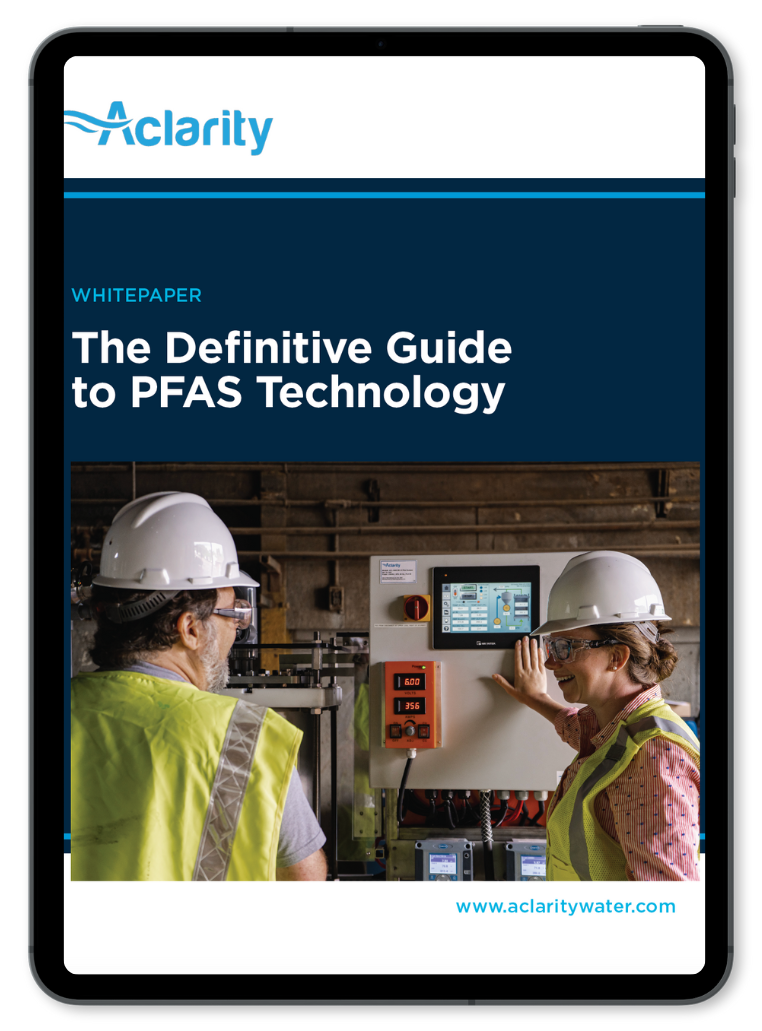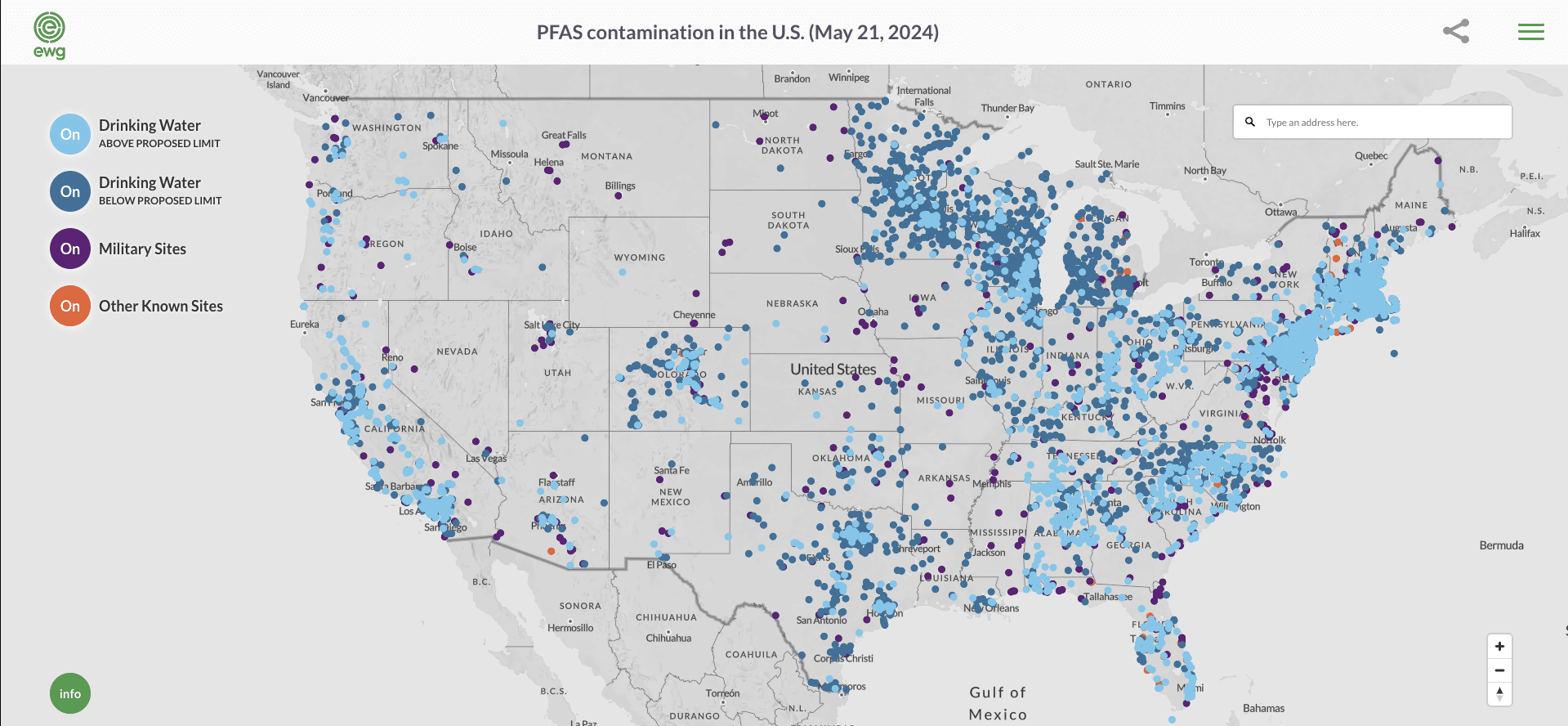A Guide to PFAS Management
July 30, 2024 | 7 minute read

PFAS (Perfluoroalkyl and poly-fluoroalkyl substances) or forever chemicals as they are more commonly referred to first emerged in the 1940’s. These versatile chemicals rapidly found their way into our homes, featuring in everything from fire repellents to waterproofs to grease proofs.
However, it has been found that these same chemicals are particularly dangerous. A quick look at Google Trends is instructive. Searches for PFAS-related terms were practically non-existent before 2020.
In the years since, a series of scientific findings have led the United States Environmental Protection Agency (US EPA) to proclaim:
- PFAS are widely used, long-lasting chemicals, components of which break down very slowly over time.
- Because of their widespread use and their persistence in the environment, many PFAS are found in the blood of people and animals all over the world and are present at low levels in a variety of food products and in the environment.
- PFAS are found in water, air, fish, and soil at locations across the nation and the globe.
- Scientific studies have shown that exposure to some PFAS in the environment may be linked to harmful health effects in humans and animals.
- There are thousands of PFAS chemicals, and they are found in many different consumer, commercial, and industrial products. This makes it challenging to study and assess the potential human health and environmental risks.
While this increased public awareness and not unrelated legislation has targeted manufacturers, it is in landfills that PFAS is proving particularly problematic. Given the ubiquity of PFAS in everyday household items, large amounts of PFAS can be found in landfills causing significant concern for landfill operators.
And the scale of the problem is significant (and growing).
PFAS Management
PFAS management refers to the different approaches that (downstream) operators can utilise to manage their PFAS challenges.
They can be roughly broken up into three main buckets.
- PFAS Monitoring/Testing
- PFAS Removal/ Disposal
- PFAS Destruction
1. PFAS Monitoring/Testing
In order to properly manage PFAS, monitoring and testing of PFAS must be implemented. However there is a unique challenge with PFAS as there are still bottlenecks to real time monitoring. Testing for PFAS at present requires sending samples to 3rd party accredited labs and oftentimes waiting weeks for results. There are, however, more novel ways to test for PFAS including biological and chemical sensing tests that show promising results with shorter lead times. Some larger centralized waste treatment facilities will implement their own, in-house equipment to test for PFAS. The most common being Liquid Chromatography–Mass Spectrometry (LC-MS), a widely used technique for PFAS testing.. The EPA has developed, validated, and published three methods—533, 537, and 537.1—to support the analysis of 29 PFAS in drinking water.
2. PFAS Removal/ Disposal
With PFAS removal, you are removing PFAS from a site and moving it to another site where it can be disposed of or contained. These would typically include landfills and deep well sites.
Examples of these include:
Granular Activated Carbon (GAC)
GAC is highly effective for removing PFAS from landfill leachate when integrated into a comprehensive treatment process. Its high surface area and strong affinity for organic compounds enable it to adsorb most PFAS molecules efficiently. Factors such as contact time, background organics, temperature, and pH affect GAC’s adsorption capacity, with longer contact times and higher temperatures typically enhancing removal efficiency. Although GAC is versatile in treating different leachate types, it is a consumable material, requiring regular disposal or regeneration to prevent potential PFAS re-release.
Foam Fractionation
Foam Fractionation leverages the surface-active properties of PFAS compounds for separation. This technique introduces air or gas into the leachate to create foam, which concentrates PFAS compounds due to their hydrophobic nature. The process can achieve high concentration factors, sometimes up to 100,000 times. It requires precise control of parameters such as pH, temperature, and foam-promoting agents. The efficiency of foam fractionation is influenced by the characteristics of the PFAS compounds, with longer chains being more favorable. The produced foamate requires a disposal step, necessitating that landfill operators develop a plan for managing and disposing of the concentrated PFAS after the concentration process.
Deep Well Injection
This technique involves injecting PFAS waste deep underground into wells drilled in porous geological formations. While it can help mitigate PFAS, some wells may not accept PFAS waste, and the transportation costs can be prohibitive. Concerns about its viability and true environmental impact raise questions about whether it effectively removes PFAS from the environment.
Solidification
Solidification entails mixing PFAS-contaminated material with binders like cement to create a stable, less mobile solid matrix, minimizing the risk of PFAS spreading and allowing for controlled management and disposal. It can be cost-effective with highly concentrated PFAS in small volumes. However, there are concerns about the leachability of PFAS from the porous cement, potentially deferring the problem rather than addressing it, given that PFAS can outlast the landfills.
Incineration
Burning PFAS at temperatures above 1400 degrees Celsius has been shown to break down PFAS compounds. However, there are concerns about potential PFAS release into the atmosphere. The US EPA has considered imposing a federal ban on PFAS incineration, with some states and the Department of Defense having already implemented such bans. This shift underscores the need for alternative methods to address PFAS contamination effectively.
However, the removal and disposal approach is often criticized as “kick the ball down the road” and as such is increasingly viewed as a less feasible option in many contexts due to the related transport costs, and increased public resistance to moving PFAS around and merely disposing instead of eradicating.

The Definitive Guide to PFAS Technology Whitepaper
Comprehensive guide to understanding PFAS management strategies to reduce risk and safeguard environmental and public health.
Stay current on advantages and disadvantages of technologies available for PFAS:
- Removal
- Disposal
- Destruction
3. PFAS Destruction
PFAS destruction relates to more modern and innovative approaches that look to destroy PFAS in situ. The advantage here is that transporting costs and risks are removed. However, the approaches used can vary quite considerably. One example of PFAS destruction is Aclarity’ Electrochemical Oxidation (EOx) which breaks PFAS bonds, breaking the PFAS cycle for good.
“We eliminate the need to transport PFAS wastewater, reduce risk from existing and upcoming state and federal discharge regulations and stop the pollution cycle by destroying PFAS forever.” Source Julie Bliss Mullen, Aclarity
Aclarity is the leader in PFAS destruction. Aclarity’s Octa™ EOx solution offers a viable approach for PFAS contaminants by destroying them in situ and thus represents an increasingly attractive route for those evaluating their options.
Summary
Traditional approaches to PFAS management was primarily a case of “kicking the ball down the road” i.e. moving the problem downstream.
PFAS destruction technology from the likes of Aclarity, offers an innovative approach to destroying PFAS forever, and represents a new era in wastewater treatment and remediation for landfills, water and wastewater treatment plants. In short, in the areas where PFAS is invariably found.
Nature is better off without PFAS. And so is your business.

The future of waste management starts now. Destruction beats disposal so we created an on-site solution that puts an end to PFAS for good. When our EOx process meets forever chemicals, the environment is not the only winner. Get a free evaluation for your PFAS destruction needs today.


